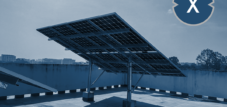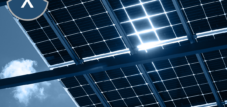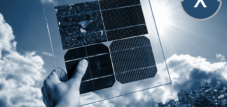Published on: March 8, 2025 / update from: March 8, 2025 - Author: Konrad Wolfenstein

Perowskit solar cells: The potential of transparent photovoltaics for modern buildings and PV projects-Image: Xpert.digital
Transparent energy transition: electricity generation through innovative window technology
Perowskit solar cells: The future makers for intelligent windows
The development of transparent solar cells with high efficiency opens up new perspectives for the integration of photovoltaics in buildings. Perowskit solar cells in particular have emerged as a promising candidate for this application in recent years. With efficiency of up to 31.6 percent, the possibility of transparent versions and inexpensive production could revolutionize solar energy use. Current research results show that the previously problematic stability of these cells could be significantly improved. Applications as intelligent window panes that not only generate electricity, but also can also adapt their transparency to the ambient conditions are forward -looking.
Suitable for:
- Smart City and wall solar solutions: Solar facades - The hidden giants of vertical energy generation - where aesthetics meets efficiency
Fundamentals of Perowskit solar technology
Perovskit solar cells represent a relatively new development in photovoltaics, which has only been researched intensively since 2009. They owe their names to the Mineral Perowskit, whose characteristic crystal structure they have. These solar cells are based on so-called Halid or Halogenid Persovskites, a hybrid material made of organic positive components such as methylammonium cations and inorganic metal salts such as lead iodide. The special material composition and structure fundamentally differs from traditional silicon solar cells and makes it a promising candidate for the future of solar energy.
The functionality of the perovskit solar cells is based on its excellent ability to convert sunlight into electrical energy. Scientists from the Jülich research center have found out that free charging carriers in perovskit solar cells are presumably protected from disintegration through new photoluminescence measurements, which could be an essential reason for their high efficiency. The lifespan of excited load carriers in the material is a decisive factor for the efficiency of these solar cells, since they determine how long the electrons released by light can be preserved and can contribute to electricity generation.
In recent years, the technological development of these solar cells has made impressive progress. While the first Perowskit solar cells still had a modest efficiency of only 4 percent, the latest models regularly achieve efficiency of more than 20 percent. The Fraunhofer Institute even achieved a record 31.6 percent, while the German company QCELLS achieved an efficiency of 28.6 percent.
Advantages of transparent perovsky solar cells
The most outstanding property of perovskit solar cells compared to conventional silicon modules is their potential transparency with high efficiency. This property opens up completely new applications, especially in the area of building -integrated photovoltaics. Transparent or semi -transparent solar cells can be integrated into window areas, which not only leaves buildings in, but can also generate electricity.
The degree of transparency can be adjusted during the manufacturing process depending on the request, whereby it should be noted that the energy conversion efficiency decreases with increasing transparency. The highest measured conversion efficiency in transparent versions is currently 17.9 percent. As part of the Impressive Research Project , it was demonstrated that a combination of technologies can convert solar energy with an efficiency of 14 percent with an average light transaction degree of more than 55 percent. Half-transparent UV-Perowskitzellen even achieve an efficiency of more than 10 percent with a light transaction degree of around 60 percent.
In addition to their transparency, perovskit solar cells are characterized by further remarkable advantages. They are relatively inexpensive and easy to manufacture, similar to thin-layer solar modules. Manufacture is much less energy-intensive compared to silicon, since perowsian can be produced using simple, scalable methods such as roll-to-roll printing techniques. In addition, the raw materials required are usually plentiful, which keeps the material costs low.
Another decisive advantage is the lightness and flexibility of the perovsky solar cells. They can be applied to different substrates as a wafer -thin layer, which significantly expands their uses. This property enables innovative applications in portable devices, vehicles or building integrated photovoltaic solutions such as solar windows or facade modules.
Innovative applications in building integration
The possibility of making perovskit solar cells transparent makes it particularly attractive for the building-integrated photovoltaic (BIPV), in which solar cells replace classic building materials such as windows. The embedding of the perovskit between glass panes enables the solar cells to serve as the actual facade and wall of a building, while at the same time generating electricity for use on site or feeding on the network.
A concrete example of this innovative application presented Panasonic Holdings, which presented semi-transparent glass balustrades with perovsky solar cells on the balcony of a model house south of Tokyo. These prototypes demonstrate the potential to integrate perovskit technology into everyday building elements. Leipzig physicists have also developed a transparent solar cell that can be evaporated directly to a window pane and could thus turn entire facades into power plants.
Developments in the field of thermochrome or “smart” windows are particularly forward -looking. Scientists at the University of California in Berkeley have developed a functional extension into a photovoltaic active window, which changes its color and transparency when the temperature changes and can generate electricity in the darkened state. The reversible change to a colored solar window is based on a phase change of wafer-thin perovskit layers.
In the transparent state, the perovskit crystals are available in a cubic structure and are largely transparent, while at a temperature of about 105 degrees Celsius they pass into a less transparent but photovoltaic crystal structure. This blocks about two thirds of the visible light and achieves an efficiency of seven percent. Cooled up to room temperature and exposed to some moisture, this change of phase can be reversed, and the window will be transparent again.
Suitable for:
- Solar pavilion in the city: Innovative photovoltaics roofing for cities with partial transparent solar modules - the 'Smart City' city solar pavilion
Thermochrome properties for climate -optimized buildings
The thermochrome properties of perovskit-based windows could make a significant contribution to the energy efficiency of buildings. Similar to self -tinting sunglasses, these windows can change their color when the temperature change, the temperature - in contrast to the light intensity in the event of sunglasses - is the decisive factor. As the temperature rises, the transparent disc color turns gradually yellow, orange, red or brown. The hotter it gets, the darker the glass becomes, which means that the room can be cooled automatically and without using air conditioning.
This mechanism can contribute significantly to reduce the energy requirement for heating and cooling. In view of the fact that heating and hot water in Austria are responsible for 25 percent of CO2 emissions and, according to a study by the University of Birmingham, the number of cooling devices worldwide should quadruple to 14 billion times by 2050, such intelligent window solutions could make an important contribution to climate protection.
Challenges and solutions
Despite the promising properties, perovskit solar cells faces some challenges that have so far restricted their broad commercial application. A main problem is its stability under real environmental conditions. Perowskit crystals tend to grow disorganized and defective, which can lead to stability problems. You do not yet reach the longevity of silicon solar cells and are sensitive to moisture, light and heat. There is a significant disadvantage in the lower weather resistance, since the material can decompose in extreme weather conditions.
However, research has already made significant progress in overcoming these challenges. For example, Panasonic has succeeded in producing a more chemically stable variant of the material and protecting it from weather conditions by using double glass. breakthrough in research on Perowskit solar modules in cooperation with the University of Cyprus . In a two-year study outdoors in Cyprus, the long-term stability of mini-perovskit modules was detected, which after one year outdoors achieved impressive energy efficiency of 78 percent-a value that current perovsky solar modules can often only maintain for a few weeks.
Progress has also been made in the area of recycling. Researchers from Sweden have developed a method to completely and environmentally friendly perovsky solar cells. Instead of using the toxic dimethyl formamide when disassembling the cells, the team uses water as a solvent to reduce the crumbled perovskite. All parts can then be reused in a new Perowskit solar cell without impairing the performance-the recycled solar cell has the same efficiency as the original.
There are still specific challenges for thermochrome solar windows. The relatively high phase change temperature of just over 100 degrees Celsius would have to be reduced for practical applications. In addition, the moisture that is necessary for reversible switching could affect the stability of the Perowskit layers in the long run. However, since the composition of perovskit materials can be varied greatly, material mixtures could be found in other studies without these disadvantages and the efficiency increased.
Market potential and future prospects
The combination of flexibility, cost advantages and outstanding efficiency makes Perowskit solar cells a hope of the energy transition. Market researchers of Idteechex predict that the market for perovskit photovoltaics will reach an annual sales volume of almost $ 12 billion by 2035. In the future, this technology could replace silicon-based modules as a dominant technology of photovoltaics.
The combination of perovsky with silicon in tandem cells appears particularly promising, which could achieve efficiency of up to 43 percent-a clear progress compared to pure silicon modules. Perovskit materials can be specially adapted to use different wavelengths of the sunlight efficiently: While perovskit is better absorbed short-wave (blue) light, silicon scores in the long-wave (red) area.
For the building-integrated photovoltaic, transparent perovskit solar cells open up completely new perspectives. In order to replace passive windows as quickly as possible with electricity-producing windows, researchers are working on optimizing the performance of the technologies and promoting the market maturity of the transparent PV cells. If it is possible to overcome the still existing challenges regarding stability and durability, perovskit-based solar windows could make a significant contribution to decentralized energy generation in urban spaces in the near future.
Urban energy transition: power-generating windows with perovskit technology
Perowskit solar cells, especially in their transparent execution for window applications , represent a promising technology for the future of photovoltaics. With their combination of high efficiency, transparency, low manufacturing costs and flexibility, they offer significant advantages over conventional silicon solar cells. The possibility of transforming buildings and windows into power generators without affecting their primary function could make a decisive contribution to the energy transition in urban rooms.
The recent progress in improving the stability and longevity of these cells under real environmental conditions are encouraging and pave the way for a broader commercial application. The thermochrome properties of some perovskit-based windows appear particularly innovative that not only generate electricity, but can also contribute to the energy efficiency of buildings by adapting their transparency.
While there are still some challenges, the rapid development of perovsky technology in recent years indicates that transparent solar cells with high efficiency could soon play an important role in architecture and energy supply. The future of construction could be changed sustainably by this innovative technology - with buildings whose windows and facades are not only aesthetically appealing, but also actively contribute to energy supply.
Suitable for:
Your global marketing and business development partner
☑️ Our business language is English or German
☑️ NEW: Correspondence in your national language!
I would be happy to serve you and my team as a personal advisor.
You can contact me by filling out the contact form or simply call me on +49 89 89 674 804 (Munich) . My email address is: wolfenstein ∂ xpert.digital
I'm looking forward to our joint project.













